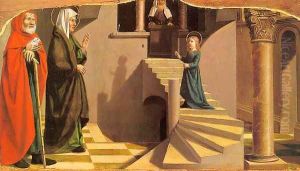Nicolas Dipre Paintings
Nicolas Dipre was a French Early Renaissance painter, whose life and work are not thoroughly documented, leading to uncertainty regarding the exact dates of his birth and death. He is believed to have been born around 1495, possibly in Avignon or in the surrounding region of Provence. The lack of precise biographical information has left art historians with a fragmented understanding of his life and career.
Dipre came from an artistic family; his father, Jean Dipre, was also a painter, and his brother, François Dipre, was a miniaturist. This familial background likely provided Nicolas with his initial training and exposure to the world of art. His style suggests that he was influenced by Provençal art, as well as by contemporary Italian Renaissance masters, which could indicate that he traveled to Italy or had access to Italianate works that were circulating in France during this period.
His active period as an artist seems to have been in the early 16th century, with a number of works attributed to him dating from this time. Dipre's art is characterized by a blend of Gothic and Renaissance elements, displaying a narrative quality with detailed, expressive figures and vibrant colors. One of his most notable works is the 'Annunciation', which showcases his talent for composition and his ability to imbue traditional religious scenes with a sense of intimacy and emotional depth.
Despite the appreciation of his artwork, Nicolas Dipre's life remains enigmatic, with no records of his death or later life. It is assumed that his career declined towards the end of his life, as was common for many artists of his era. Consequently, his death date is unrecorded and remains unknown. Nonetheless, Nicolas Dipre's contributions to French Renaissance art are recognized through the few remaining works that are attributed to him, which continue to be studied and admired for their unique blend of stylistic elements and their portrayal of religious narratives.
